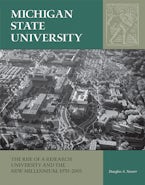In the 1960s and ’70s, Michigan State College transformed into the major research institution known today as Michigan State University, a true “megaversity.” Michigan State University, the final volume of this trilogy, explores the history of that transformation and the growing pains the school endured as it became a part of the Association of American Universities. From President John A. Hannah’s vision, the new university has been defined by rapid expansion, growth, new opportunities, and the occasional crisis. Its development has been a massive undertaking that marshaled individuals, research interests, federal funds, state appropriations, and more.
Through the vicissitudes of government funding and other challenges, the university has established itself as a renowned research and educational institution with a remarkably rich array of facilities, scientists, and researchers who continue to make landmark contributions to their fields. At the same time it has strived to be known for its accessibility, diversity, equality of opportunity, and antidiscrimination policies and practices. Michigan State University sheds new light on the growth of this dynamic and multifaceted institution.
ContentsPrefaceChapter One: The Emergence of the Research University in the 1950s and 1960sChapter Two: The University in the Vortex of History and Social ChangeChapter Three: Financial Crisis and Its ImpactChapter Four: A Steady State Period and Its Salutary EffectsChapter Five: Growth, Expansion, and DistinctionConclusion: Looking Back through the Lens of the Sesquicentennial and Looking AheadBibliographyIndex

